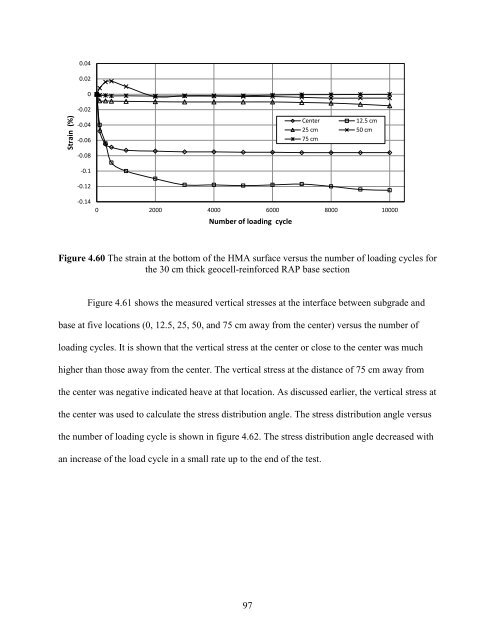Onsite Use of Recycled Asphalt Pavement Materials and Geocells to ...
Onsite Use of Recycled Asphalt Pavement Materials and Geocells to ...
Onsite Use of Recycled Asphalt Pavement Materials and Geocells to ...
You also want an ePaper? Increase the reach of your titles
YUMPU automatically turns print PDFs into web optimized ePapers that Google loves.
Strain (%)<br />
0.04<br />
0.02<br />
0<br />
-0.02<br />
-0.04<br />
-0.06<br />
-0.08<br />
-0.1<br />
-0.12<br />
-0.14<br />
0 2000 4000 6000 8000 10000<br />
Number <strong>of</strong> loading cycle<br />
Figure 4.60 The strain at the bot<strong>to</strong>m <strong>of</strong> the HMA surface versus the number <strong>of</strong> loading cycles for<br />
the 30 cm thick geocell-reinforced RAP base section<br />
Figure 4.61 shows the measured vertical stresses at the interface between subgrade <strong>and</strong><br />
base at five locations (0, 12.5, 25, 50, <strong>and</strong> 75 cm away from the center) versus the number <strong>of</strong><br />
loading cycles. It is shown that the vertical stress at the center or close <strong>to</strong> the center was much<br />
higher than those away from the center. The vertical stress at the distance <strong>of</strong> 75 cm away from<br />
the center was negative indicated heave at that location. As discussed earlier, the vertical stress at<br />
the center was used <strong>to</strong> calculate the stress distribution angle. The stress distribution angle versus<br />
the number <strong>of</strong> loading cycle is shown in figure 4.62. The stress distribution angle decreased with<br />
an increase <strong>of</strong> the load cycle in a small rate up <strong>to</strong> the end <strong>of</strong> the test.<br />
97<br />
Center 12.5 cm<br />
25 cm 50 cm<br />
75 cm
















